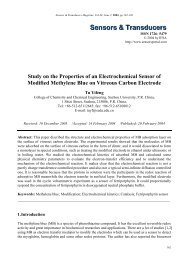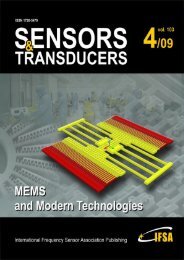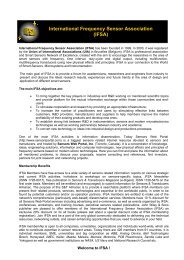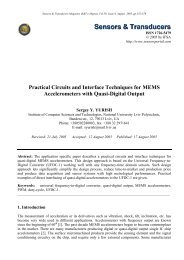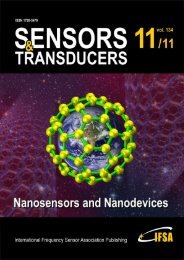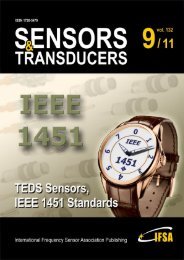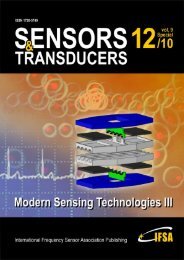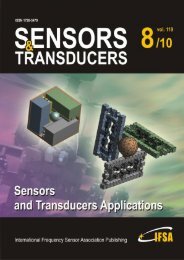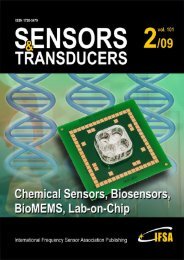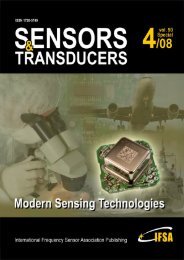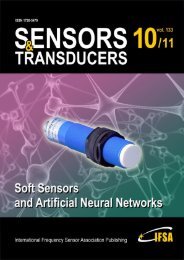Adaptive PI Controller for a Nonlinear System - International ...
Adaptive PI Controller for a Nonlinear System - International ...
Adaptive PI Controller for a Nonlinear System - International ...
You also want an ePaper? Increase the reach of your titles
YUMPU automatically turns print PDFs into web optimized ePapers that Google loves.
Sensors & TransducersVolume 109, Issue 10October 2009www.sensorsportal.com ISSN 1726-5479Editors-in-Chief: professor Sergey Y. Yurish,Phone: +34 696067716, fax: +34 93 4011989, e-mail: editor@sensorsportal.comEditors <strong>for</strong> Western EuropeMeijer, Gerard C.M., Delft University of Technology, The NetherlandsFerrari, Vittorio, Universitá di Brescia, ItalyEditor South AmericaCosta-Felix, Rodrigo, Inmetro, BrazilEditor <strong>for</strong> Eastern EuropeSachenko, Anatoly, Ternopil State Economic University, UkraineAbdul Rahim, Ruzairi, Universiti Teknologi, MalaysiaAhmad, Mohd Noor, Nothern University of Engineering, MalaysiaAnnamalai, Karthigeyan, National Institute of Advanced Industrial Scienceand Technology, JapanArcega, Francisco, University of Zaragoza, SpainArguel, Philippe, CNRS, FranceAhn, Jae-Pyoung, Korea Institute of Science and Technology, KoreaArndt, Michael, Robert Bosch GmbH, GermanyAscoli, Giorgio, George Mason University, USAAtalay, Selcuk, Inonu University, TurkeyAtghiaee, Ahmad, University of Tehran, IranAugutis, Vygantas, Kaunas University of Technology, LithuaniaAvachit, Patil Lalchand, North Maharashtra University, IndiaAyesh, Aladdin, De Mont<strong>for</strong>t University, UKBahreyni, Behraad, University of Manitoba, CanadaBaliga, Shankar, B., General Monitors Transnational, USABaoxian, Ye, Zhengzhou University, ChinaBar<strong>for</strong>d, Lee, Agilent Laboratories, USABarlingay, Ravindra, RF Arrays <strong>System</strong>s, IndiaBasu, Sukumar, Jadavpur University, IndiaBeck, Stephen, University of Sheffield, UKBen Bouzid, Sihem, Institut National de Recherche Scientifique, TunisiaBenachaiba, Chellali, Universitaire de Bechar, AlgeriaBinnie, T. David, Napier University, UKBischoff, Gerlinde, Inst. Analytical Chemistry, GermanyBodas, Dhananjay, IMTEK, GermanyBorges Carval, Nuno, Universidade de Aveiro, PortugalBousbia-Salah, Mounir, University of Annaba, AlgeriaBouvet, Marcel, CNRS – UPMC, FranceBrudzewski, Kazimierz, Warsaw University of Technology, PolandCai, Chenxin, Nanjing Normal University, ChinaCai, Qingyun, Hunan University, ChinaCampanella, Luigi, University La Sapienza, ItalyCarvalho, Vitor, Minho University, PortugalCecelja, Franjo, Brunel University, London, UKCerda Belmonte, Judith, Imperial College London, UKChakrabarty, Chandan Kumar, Universiti Tenaga Nasional, MalaysiaChakravorty, Dipankar, Association <strong>for</strong> the Cultivation of Science, IndiaChanghai, Ru, Harbin Engineering University, ChinaChaudhari, Gajanan, Shri Shivaji Science College, IndiaChavali, Murthy, VIT University, Tamil Nadu, IndiaChen, Jiming, Zhejiang University, ChinaChen, Rongshun, National Tsing Hua University, TaiwanCheng, Kuo-Sheng, National Cheng Kung University, TaiwanChiang, Jeffrey (Cheng-Ta), Industrial Technol. Research Institute, TaiwanChiriac, Horia, National Institute of Research and Development, RomaniaChowdhuri, Arijit, University of Delhi, IndiaChung, Wen-Yaw, Chung Yuan Christian University, TaiwanCorres, Jesus, Universidad Publica de Navarra, SpainCortes, Camilo A., Universidad Nacional de Colombia, ColombiaCourtois, Christian, Universite de Valenciennes, FranceCusano, Andrea, University of Sannio, ItalyD'Amico, Arnaldo, Università di Tor Vergata, ItalyDe Stefano, Luca, Institute <strong>for</strong> Microelectronics and Microsystem, ItalyDeshmukh, Kiran, Shri Shivaji Mahavidyalaya, Barshi, IndiaDickert, Franz L., Vienna University, AustriaDieguez, Angel, University of Barcelona, SpainDimitropoulos, Panos, University of Thessaly, GreeceDing, Jianning, Jiangsu Polytechnic University, ChinaEditorial Advisory BoardEditors <strong>for</strong> North AmericaDatskos, Panos G., Oak Ridge National Laboratory, USAFabien, J. Josse, Marquette University, USAKatz, Evgeny, Clarkson University, USAEditor <strong>for</strong> AsiaOhyama, Shinji, Tokyo Institute of Technology, JapanEditor <strong>for</strong> Asia-PacificMukhopadhyay, Subhas, Massey University, New ZealandDjordjevich, Alexandar, City University of Hong Kong, Hong KongDonato, Nicola, University of Messina, ItalyDonato, Patricio, Universidad de Mar del Plata, ArgentinaDong, Feng, Tianjin University, ChinaDrljaca, Predrag, Instersema Sensoric SA, SwitzerlandDubey, Venketesh, Bournemouth University, UKEnderle, Stefan, Univ.of Ulm and KTB Mechatronics GmbH, GermanyErdem, Gursan K. Arzum, Ege University, TurkeyErkmen, Aydan M., Middle East Technical University, TurkeyEstelle, Patrice, Insa Rennes, FranceEstrada, Horacio, University of North Carolina, USAFaiz, Adil, INSA Lyon, FranceFericean, Sorin, Balluff GmbH, GermanyFernandes, Joana M., University of Porto, PortugalFrancioso, Luca, CNR-IMM Institute <strong>for</strong> Microelectronics andMicrosystems, ItalyFrancis, Laurent, University Catholique de Louvain, BelgiumFu, Weiling, South-Western Hospital, Chongqing, ChinaGaura, Elena, Coventry University, UKGeng, Yanfeng, China University of Petroleum, ChinaGole, James, Georgia Institute of Technology, USAGong, Hao, National University of Singapore, SingaporeGonzalez de la Rosa, Juan Jose, University of Cadiz, SpainGranel, Annette, Goteborg University, SwedenGraff, Mason, The University of Texas at Arlington, USAGuan, Shan, Eastman Kodak, USAGuillet, Bruno, University of Caen, FranceGuo, Zhen, New Jersey Institute of Technology, USAGupta, Narendra Kumar, Napier University, UKHadjiloucas, Sillas, The University of Reading, UKHaider, Mohammad R., Sonoma State University, USAHashsham, Syed, Michigan State University, USAHasni, Abdelhafid, Bechar University, AlgeriaHernandez, Alvaro, University of Alcala, SpainHernandez, Wilmar, Universidad Politecnica de Madrid, SpainHomentcovschi, Dorel, SUNY Binghamton, USAHorstman, Tom, U.S. Automation Group, LLC, USAHsiai, Tzung (John), University of Southern Cali<strong>for</strong>nia, USAHuang, Jeng-Sheng, Chung Yuan Christian University, TaiwanHuang, Star, National Tsing Hua University, TaiwanHuang, Wei, PSG Design Center, USAHui, David, University of New Orleans, USAJaffrezic-Renault, Nicole, Ecole Centrale de Lyon, FranceJaime Calvo-Galleg, Jaime, Universidad de Salamanca, SpainJames, Daniel, Griffith University, AustraliaJanting, Jakob, DELTA Danish Electronics, DenmarkJiang, Liudi, University of Southampton, UKJiang, Wei, University of Virginia, USAJiao, Zheng, Shanghai University, ChinaJohn, Joachim, IMEC, BelgiumKalach, Andrew, Voronezh Institute of Ministry of Interior, RussiaKang, Moonho, Sunmoon University, Korea SouthKaniusas, Eugenijus, Vienna University of Technology, AustriaKatake, Anup, Texas A&M University, USAKausel, Wilfried, University of Music, Vienna, AustriaKavasoglu, Nese, Mugla University, TurkeyKe, Cathy, Tyndall National Institute, IrelandKhan, Asif, Aligarh Muslim University, Aligarh, IndiaSapozhnikova, Ksenia, D.I.Mendeleyev Institute <strong>for</strong> Metrology, Russia
Kim, Min Young, Kyungpook National University, Korea SouthKo, Sang Choon, Electronics and Telecommunications Research Institute,Korea SouthKockar, Hakan, Balikesir University, TurkeyKotulska, Malgorzata, Wroclaw University of Technology, PolandKratz, Henrik, Uppsala University, SwedenKumar, Arun, University of South Florida, USAKumar, Subodh, National Physical Laboratory, IndiaKung, Chih-Hsien, Chang-Jung Christian University, TaiwanLacnjevac, Caslav, University of Belgrade, SerbiaLay-Ekuakille, Aime, University of Lecce, ItalyLee, Jang Myung, Pusan National University, Korea SouthLee, Jun Su, Amkor Technology, Inc. South KoreaLei, Hua, National Starch and Chemical Company, USALi, Genxi, Nanjing University, ChinaLi, Hui, Shanghai Jiaotong University, ChinaLi, Xian-Fang, Central South University, ChinaLiang, Yuanchang, University of Washington, USALiawruangrath, Saisunee, Chiang Mai University, ThailandLiew, Kim Meow, City University of Hong Kong, Hong KongLin, Hermann, National Kaohsiung University, TaiwanLin, Paul, Cleveland State University, USALinderholm, Pontus, EPFL - Microsystems Laboratory, SwitzerlandLiu, Aihua, University of Oklahoma, USALiu Changgeng, Louisiana State University, USALiu, Cheng-Hsien, National Tsing Hua University, TaiwanLiu, Songqin, Southeast University, ChinaLodeiro, Carlos, Universidade NOVA de Lisboa, PortugalLorenzo, Maria Encarnacio, Universidad Autonoma de Madrid, SpainLukaszewicz, Jerzy Pawel, Nicholas Copernicus University, PolandMa, Zhanfang, Northeast Normal University, ChinaMajstorovic, Vidosav, University of Belgrade, SerbiaMarquez, Alfredo, Centro de Investigacion en Materiales Avanzados,MexicoMatay, Ladislav, Slovak Academy of Sciences, SlovakiaMathur, Prafull, National Physical Laboratory, IndiaMaurya, D.K., Institute of Materials Research and Engineering, SingaporeMekid, Samir, University of Manchester, UKMelnyk, Ivan, Photon Control Inc., CanadaMendes, Paulo, University of Minho, PortugalMennell, Julie, Northumbria University, UKMi, Bin, Boston Scientific Corporation, USAMinas, Graca, University of Minho, PortugalMoghavvemi, Mahmoud, University of Malaya, MalaysiaMohammadi, Mohammad-Reza, University of Cambridge, UKMolina Flores, Esteban, Benemérita Universidad Autónoma de Puebla,MexicoMoradi, Majid, University of Kerman, IranMorello, Rosario, University "Mediterranea" of Reggio Calabria, ItalyMounir, Ben Ali, University of Sousse, TunisiaMulla, Imtiaz Sirajuddin, National Chemical Laboratory, Pune, IndiaNeelamegam, Periasamy, Sastra Deemed University, IndiaNeshkova, Milka, Bulgarian Academy of Sciences, BulgariaOberhammer, Joachim, Royal Institute of Technology, SwedenOuld Lahoucine, Cherif, University of Guelma, AlgeriaPamidighanta, Sayanu, Bharat Electronics Limited (BEL), IndiaPan, Jisheng, Institute of Materials Research & Engineering, SingaporePark, Joon-Shik, Korea Electronics Technology Institute, Korea SouthPenza, Michele, ENEA C.R., ItalyPereira, Jose Miguel, Instituto Politecnico de Setebal, PortugalPetsev, Dimiter, University of New Mexico, USAPogacnik, Lea, University of Ljubljana, SloveniaPost, Michael, National Research Council, CanadaPrance, Robert, University of Sussex, UKPrasad, Ambika, Gulbarga University, IndiaPrateepasen, Asa, Kingmoungut's University of Technology, ThailandPullini, Daniele, Centro Ricerche FIAT, ItalyPumera, Martin, National Institute <strong>for</strong> Materials Science, JapanRadhakrishnan, S. National Chemical Laboratory, Pune, IndiaRajanna, K., Indian Institute of Science, IndiaRamadan, Qasem, Institute of Microelectronics, SingaporeRao, Basuthkar, Tata Inst. of Fundamental Research, IndiaRaoof, Kosai, Joseph Fourier University of Grenoble, FranceReig, Candid, University of Valencia, SpainRestivo, Maria Teresa, University of Porto, PortugalRobert, Michel, University Henri Poincare, FranceRezazadeh, Ghader, Urmia University, IranRoyo, Santiago, Universitat Politecnica de Catalunya, SpainRodriguez, Angel, Universidad Politecnica de Cataluna, SpainRothberg, Steve, Loughborough University, UKSadana, Ajit, University of Mississippi, USASadeghian Marnani, Hamed, TU Delft, The NetherlandsSandacci, Serghei, Sensor Technology Ltd., UKSaxena, Vibha, Bhbha Atomic Research Centre, Mumbai, IndiaSchneider, John K., Ultra-Scan Corporation, USASeif, Selemani, Alabama A & M University, USASeifter, Achim, Los Alamos National Laboratory, USASengupta, Deepak, Advance Bio-Photonics, IndiaShearwood, Christopher, Nanyang Technological University, SingaporeShin, Kyuho, Samsung Advanced Institute of Technology, KoreaShmaliy, Yuriy, Kharkiv National Univ. of Radio Electronics, UkraineSilva Girao, Pedro, Technical University of Lisbon, PortugalSingh, V. R., National Physical Laboratory, IndiaSlomovitz, Daniel, UTE, UruguaySmith, Martin, Open University, UKSoleymanpour, Ahmad, Damghan Basic Science University, IranSomani, Prakash R., Centre <strong>for</strong> Materials <strong>for</strong> Electronics Technol., IndiaSrinivas, Talabattula, Indian Institute of Science, Bangalore, IndiaSrivastava, Arvind K., Northwestern University, USAStefan-van Staden, Raluca-Ioana, University of Pretoria, South AfricaSumriddetchka, Sarun, National Electronics and Computer TechnologyCenter, ThailandSun, Chengliang, Polytechnic University, Hong-KongSun, Dongming, Jilin University, ChinaSun, Junhua, Beijing University of Aeronautics and Astronautics, ChinaSun, Zhiqiang, Central South University, ChinaSuri, C. Raman, Institute of Microbial Technology, IndiaSysoev, Victor, Saratov State Technical University, RussiaSzewczyk, Roman, Industrial Research Inst. <strong>for</strong> Automation andMeasurement, PolandTan, Ooi Kiang, Nanyang Technological University, Singapore,Tang, Dianping, Southwest University, ChinaTang, Jaw-Luen, National Chung Cheng University, TaiwanTeker, Kasif, Frostburg State University, USAThumbavanam Pad, Kartik, Carnegie Mellon University, USATian, Gui Yun, University of Newcastle, UKTsiantos, Vassilios, Technological Educational Institute of Kaval, GreeceTsigara, Anna, National Hellenic Research Foundation, GreeceTwomey, Karen, University College Cork, IrelandValente, Antonio, University, Vila Real, - U.T.A.D., PortugalVaseashta, Ashok, Marshall University, USAVazquez, Carmen, Carlos III University in Madrid, SpainVieira, Manuela, Instituto Superior de Engenharia de Lisboa, PortugalVigna, Benedetto, STMicroelectronics, ItalyVrba, Radimir, Brno University of Technology, Czech RepublicWandelt, Barbara, Technical University of Lodz, PolandWang, Jiangping, Xi'an Shiyou University, ChinaWang, Kedong, Beihang University, ChinaWang, Liang, Advanced Micro Devices, USAWang, Mi, University of Leeds, UKWang, Shinn-Fwu, Ching Yun University, TaiwanWang, Wei-Chih, University of Washington, USAWang, Wensheng, University of Pennsylvania, USAWatson, Steven, Center <strong>for</strong> NanoSpace Technologies Inc., USAWeiping, Yan, Dalian University of Technology, ChinaWells, Stephen, Southern Company Services, USAWolkenberg, Andrzej, Institute of Electron Technology, PolandWoods, R. Clive, Louisiana State University, USAWu, DerHo, National Pingtung Univ. of Science and Technology, TaiwanWu, Zhaoyang, Hunan University, ChinaXiu Tao, Ge, Chuzhou University, ChinaXu, Lisheng, The Chinese University of Hong Kong, Hong KongXu, Tao, University of Cali<strong>for</strong>nia, Irvine, USAYang, Dongfang, National Research Council, CanadaYang, Wuqiang, The University of Manchester, UKYang, Xiaoling, University of Georgia, Athens, GA, USAYaping Dan, Harvard University, USAYmeti, Aurel, University of Twente, NetherlandYong Zhao, Northeastern University, ChinaYu, Haihu, Wuhan University of Technology, ChinaYuan, Yong, Massey University, New ZealandYufera Garcia, Alberto, Seville University, SpainZagnoni, Michele, University of Southampton, UKZamani, Cyrus, Universitat de Barcelona, SpainZeni, Luigi, Second University of Naples, ItalyZhang, Minglong, Shanghai University, ChinaZhang, Qintao, University of Cali<strong>for</strong>nia at Berkeley, USAZhang, Weiping, Shanghai Jiao Tong University, ChinaZhang, Wenming, Shanghai Jiao Tong University, ChinaZhang, Xueji, World Precision Instruments, Inc., USAZhong, Haoxiang, Henan Normal University, ChinaZhu, Qing, Fujifilm Dimatix, Inc., USAZorzano, Luis, Universidad de La Rioja, SpainZourob, Mohammed, University of Cambridge, UKSensors & Transducers Journal (ISSN 1726-5479) is a peer review international journal published monthly online by <strong>International</strong> Frequency Sensor Association (IFSA).Available in electronic and on CD. Copyright © 2009 by <strong>International</strong> Frequency Sensor Association. All rights reserved.
Sensors & Transducers JournalContentsVolume 109Issue 10October 2009www.sensorsportal.com ISSN 1726-5479Research ArticlesAspects of Gas Sensor´s Modeling and Implementation in a Dynamic EnvironmentHakim Baha, Zohir Dibi....................................................................................................................... 1A Fuzzy-Based Tactile Sensor <strong>for</strong> Implementation in Specialized Motion of Land RoverBadal Chakraborty, K. Rajanna.......................................................................................................... 13Neuro and Fuzzy Computing Approach <strong>for</strong> the Flow Sensorless MeasurementR. Kumar, and P. Sivashanmugam..................................................................................................... 21Fuzzy Logic Based Set-Point Weighting <strong>Controller</strong> Tuning <strong>for</strong> an Internal Model ControlBased Pid <strong>Controller</strong>Maruthai Suresh, Ranganathan Rani Hemamalini, Gunna Jeersamy Srinivasan ............................. 29<strong>Adaptive</strong> <strong>PI</strong> <strong>Controller</strong> <strong>for</strong> a <strong>Nonlinear</strong> <strong>System</strong>D. Rathikarani, D. Sivakumar. ............................................................................................................ 43Integration of Fault Detection and Isolation with Control Using Neuro-fuzzy SchemeA. Asokan, D. Sivakumar .................................................................................................................... 59Control Scheme of a Designed Step Climbing Wheeled RobotSrijan Bhattacharya, Sagarika Pal, Subrata Chattopadhyay.............................................................. 70Accurate Fluid Level Measurement in Dynamic Environment Using Ultrasonic Sensorand ν-SVMJenny Terzic, Romesh Nagarajah, Muhammad Alamgir.................................................................... 76Design of a MEMS Capacitive Comb-drive Micro-accelerometer with Sag OptimizationB. D. Pant, Lokesh Dhakar, P. J. George and S. Ahmad................................................................... 92Remarkable Electromechanical Coupling in the 2–2 Composite Based on Single-domainPMN–0.33PT CrystalVitaly Yu. Topolov, Sergei V. Glushanin, Christopher R. Bowen and Anatoly E. Panich .................. 108Effect on H 2 S Gas Sensing Per<strong>for</strong>mance of Nb 2 O 5 Addition to TiO 2 Thick FilmsC. G. Dighavkar, A. V. Patil, S. J. Patil and R. Y. Borse. ................................................................... 117Al 2 O 3 - BSST Based Chemical Sensors <strong>for</strong> Ammonia Gas SensingL. A. Patil, H. M. Baviskar................................................................................................................... 126Wireless Telemetry 2.4 GHz <strong>for</strong> Measurement Occupational VibrationDiogo Koenig and Alexandre Balbinot................................................................................................ 137pH Homeostasis Linked with Capacitance Relaxation Phenomena and ElectrostrictiveEnergy in Cancer CellsT. K. Basak, T. Ramanujam, J. C. Kavitha, Poonam Goyal, Deepali Garg, Arpita Gupta,Suman Halder..................................................................................................................................... 147Authors are encouraged to submit article in MS Word (doc) and Acrobat (pdf) <strong>for</strong>mats by e-mail: editor@sensorsportal.comPlease visit journal’s webpage with preparation instructions: http://www.sensorsportal.com/HTML/DIGEST/Submition.htm<strong>International</strong> Frequency Sensor Association (IFSA).
Sensors & Transducers Journal, Vol. 109, Issue 10, October 2009, pp. 43-58Sensors & TransducersISSN 1726-5479© 2009 by IFSAhttp://www.sensorsportal.com<strong>Adaptive</strong> <strong>PI</strong> <strong>Controller</strong> <strong>for</strong> a <strong>Nonlinear</strong> <strong>System</strong>D. Rathikarani, * D. SivakumarDept. of Instrumentation Engineering, Annamalai University,Annamalainagar – 608002, IndiaTel.: 914144223640, * 9443238642E mail: dradhikarani_2k6@yahoo.co.in, dsk2k5@gmail.comReceived: 28 August 2009 /Accepted: 23 October 2009 /Published: 30 October 2009Abstract: Most of the industrial processes are inherently nonlinear in their behaviour. Designs ofcontrollers <strong>for</strong> these nonlinear processes are difficult, as they do not follow superposition theorem.<strong>Adaptive</strong> controller can change its behaviour in response to changes in the dynamics of the process anddisturbances. Hence adaptive controller can be used to control nonlinear processes. Direct ModelReference <strong>Adaptive</strong> Control is a technique, in which a reference model involving the desiredper<strong>for</strong>mances is specified. In the present work, a DMRAC is designed and implemented to achievesatisfactory control of a nonlinear system in all its local linear operating regions. The closed loopsystem is made BIBO stable by proper control techniques. The controller is designed throughsimulation in Matlab plat<strong>for</strong>m and is validated in real time by conducting experiments on thelaboratory Air Flow Control <strong>System</strong> using the dSPACE interface. Copyright © 2009 IFSA.Keywords: <strong>Nonlinear</strong> system, Direct model reference adaptive control (DMRAC), <strong>Adaptive</strong> MITcontrol, <strong>Adaptive</strong> <strong>PI</strong> control, Fixed gain controller1. IntroductionControl of nonlinear dynamic system is a challenging task because nonlinear processes do not sharemany properties with linear system [1]. The knowledge about a system and its environment is requiredapriori to design a control strategy [2]. The most commonly used control techniques <strong>for</strong> nonlinearsystems are the <strong>PI</strong>D control [3], optimal control, adaptive control [4] and robust control. <strong>Adaptive</strong>control schemes [4, 5] are useful <strong>for</strong> systems with unknown or slowly time-varying or nonlinearprocesses and represent a class of advanced control algorithms. On the other hand, <strong>PI</strong>D [6–8] controlalgorithms still continue to be widely used <strong>for</strong> solving industrial control systems, particularly in the43
Sensors & Transducers Journal, Vol. 109, Issue 10, October 2009, pp. 43-58chemical process industries. This is mainly because <strong>PI</strong>D controllers have simple control structures andare easy to maintain and tune. Hence it is still attractive to design an advanced control systems with<strong>PI</strong>D control structures. One may not be able to get good control per<strong>for</strong>mance in the case of nonlinearprocesses. In order to improve the closed loop response of the nonlinear process, Model Reference<strong>Adaptive</strong> Control [9-10], auto tuning [11–13] and self-tuning <strong>PI</strong>D control [14–21] can be designed.In this paper a procedure to design and implement DMRACs after modelling a nonlinear system isproposed. The basic idea of modelling is to represent the nonlinear system into a family of local linearmodels. Each linear model represents the dynamics of the complex system in that particular localregion. These models are used to design local controllers specific to that region.<strong>Adaptive</strong> MIT and <strong>Adaptive</strong> <strong>PI</strong> controllers are designed and implemented <strong>for</strong> a nonlinear air flowcontrol system. The designed controller has a conventional inner loop followed by a separate adaptiveouter loop to adjust the controller’s gains (theta1, θ 1 , theta2, θ 2 , Proportional gain, K P , Integral gain,K I ) based on the modelling error to equalize the coefficients of closed loop plant to the coefficients ofthe plant model [2, 18, 22]. The advantage is that the proposed technique can deal with the nonlinearnature of the process and also retain the designer’s intuition and insight through the relatively simpledesign scheme that is proposed. Hence, the plant output converges to model’s output. The control lawis implemented using DS1104 board of dSPACE interface with the process to per<strong>for</strong>m experimentationand the results are analyzed.There is no guarantee that the <strong>Adaptive</strong> MIT and <strong>Adaptive</strong> <strong>PI</strong> controllers can provide a stable closedloop per<strong>for</strong>mance. Hence the closed loop system is made bounded input, bounded output stable(BIBO) by maintaining the gain of the closed loop system within limits always.The rest of the paper is organized as follows. Section 2 describes the nonlinear air flow control systemavailable in our lab, section 3 deals with the system modelling, section 4 and 5 discusses adaptivecontroller design and analysis with the stabilizing set of controller. A sample case from simulation andalso from real time implementation along with the results are presented in section 6 which is followedby concluding remarks in section 7.2. Laboratory Air Flow Control <strong>System</strong>The process considered in this paper is a simple model of air flow process. The important aspect of theprocess is its simplicity. This is mildly nonlinear and can show acceptable range of linearization. Thisprocess can be modeled as First Order Plus Time Delay Process and the model dynamics depend onoperating conditions. The piping and instrumentation diagram (Fig. 1) depicts the entire process and itsassociated control system. The controlled variable (air flow rate) is sensed by an appropriate sensor(differential pressure flow transmitter). This flow transmitter produces current output in the range of4 to 20 mA. A current to voltage (I/V) converter is used to convert 4 to 20 mA into 1 to 5 Volts. Thismeasured voltage (controlled variable) is compared with the reference signal. The difference betweenthe two is given as input to the DMRAC. The controller produces manipulating variable based on theidentified Process Parameters and the difference between the set point and controlled variable. Themanipulating variable in voltage <strong>for</strong>m is converted into current by a Voltage/Current (V/I) converter.A Current/Pneumatic (I/P) converter is used to convert this current to pressure (3 to 15 psi) acceptedby the control valve. The air failure to open (AFO) pneumatic control valve restricts the path of the airflow in the process pipe line, thus controlling the air flow rate. The process gain <strong>for</strong> various flow ratesin the process pipe line are shown in Fig. 2. The process shows the hysteresis nonlinearity in itscharacter. The dynamic characteristic of the Final Control Element with Differential Pressure FlowTransmitter is shown in Fig. 3.The modeling and identification of the process is continued in the nextsection.44
Sensors & Transducers Journal, Vol. 109, Issue 10, October 2009, pp. 43-58V1 to V4 - Manifold valves; FT - Flow Transmitter; MV-1 to MV-3 - Manual control valves; PS - PowerSupply; M1 and M2 - Manometer connections; mA - Milliammeter; DH - De humidifier; I/P - Current toPressure converter; AFR - Air Filter Regulator; PCV - Pneumatic Control Valve; PRG - Pressure Gauge ;G-2 - Galvanized pipe <strong>for</strong> cold air flow.Fig. 1. Piping and Instrumentation Diagram of Air Flow Control <strong>System</strong>4Process gain32100 500 1000Flow rate(lpm)--------- Increasing Flow Rate- - - - - - Decreasing Flow RateFig. 2. Characteristics of Air Flow Process.Fig. 3.Characteristic of Air Flow Control <strong>System</strong>.45
Sensors & Transducers Journal, Vol. 109, Issue 10, October 2009, pp. 43-583. Identification of ProcessThe model of the process is not needed <strong>for</strong> the design of DMRACs. Be<strong>for</strong>e implementing the controlalgorithm in real time, the designer has to observe the per<strong>for</strong>mance by various simulation studies. Inorder to design controllers through simulation, the actual process need to be modeled. Hence theprocedure <strong>for</strong> identification of the nonlinear air flow process is outlined in this section. Identificationrefers to the process of selecting a model structure first, then estimating its parameters [23]. Thegeneral First Order plus Time Delay Process (FOPTD) is given byG(s)=−LsKe, (1)Ts + 1where K represents the steady-state gain of the process, L represents the time delay and T representsthe time constant of the process. The process parameters <strong>for</strong> different operating condition are estimatedby Two point Method [1]. Neglecting the time delay, the process model is approximated as First OrderProcess (FOP)The process parameters are determined as follows:whereK( s)= Ts + 1∆ Y is the change in output and ∆ U is the change in input.G (2)∆YK = , (3)∆ UT = .5 * ( T 2− T ) , (4)11where T 1 is the time taken by the process to reach 28.3 % of the final steady state value.T 2 is the timetaken by the process to reach 63.2 % of the final steady state value. 50% of the collected real time dataare used <strong>for</strong> modeling and the remaining 50 % are used <strong>for</strong> model validation [23].The identified FOP models are given in Table I. The time domain validation of the model with theactual process is presented in Fig. 4. The obtained responses reveal the degree of closeness of theestimated FOP model with that of the actual process.Flow rate(Lpm)350300250200150100 110 120 130 140Time (sec)-------Actual Process response------- Model responseFig. 4. Response of the identified Model and actual process.46
Sensors & Transducers Journal, Vol. 109, Issue 10, October 2009, pp. 43-58Table I. Identified Models.Flow rate(lpm)Identified ModelFlow rate(lpm)Identified ModelFlow rate(lpm)Identified Model5 – 1340.01592M 1( s)=872 – 10250.475s+ 11.3548M 7 ( s)=872 – 7250.475s+ 1M13 (0.9168s)=0.475s+ 1134 – 2800.0252M 2( s)=1025 – 11700.475s+ 12.2488M 8 ( s)=725 – 5750.475s+ 1M14 (0.5281s)=0.475s+ 1280 – 4280.0683M 3 ( s)=1170 – 13190.475s+ 14.0796M 9 ( s)=575 – 4280.475s+ 1M15 (0.2654s)=0.475s+ 1428 – 5750.2194M 4 ( s)=1319 – 11700.475s+ 14.0768M 10 ( s)=428 – 2800.475s+ 1M16 (0.0692s)=0.475s+ 1575 – 7250.4188M 5 ( s)=1170 – 10250.475s+ 12.5045M 11( s)=280 – 1340.475s+ 1M170.0505( s)=0.475s+ 1725 – 8720.8195M 6( s)=1025 – 8720.475s+ 11.4522M 12 ( s)=134 – 150.475s+ 1M18 (0.01536s)=0.475s+ 14. <strong>Adaptive</strong> Control AlgorithmThe Block Diagram Representation of DMRACs implemented in this work is presented in Fig. 5. Thecontrol system consists of two loops. The inner conventional feedback loop is composed of the processand the controller. The outer loop is <strong>for</strong> Parameter Adjustment Algorithm (PAA) with decision block.The decision, comparator in the figure decides input to the controller based on the input range (U C ) andstability condition (equation (31) and (32)). The PAA updates the controller parameters after satisfyingthe stability criterion <strong>for</strong> the specific range. The fixed gain controller block is placed in theconventional loop if PAA does not satisfy the stability criterion.ModelFixed Gain controllerY MDecision andComparison<strong>Adaptive</strong> Mechanism (PAA) eeYU C<strong>Controller</strong>ProcessFig. 5. Block Diagram Representation of Direct Model Reference <strong>Adaptive</strong> Control.47
Sensors & Transducers Journal, Vol. 109, Issue 10, October 2009, pp. 43-58The outer loop adjusts the controller parameter in such a way that the model error (e), the differencebetween process output Y and model output Y M is smalle = Y −(5)Y MThe controller parameters may be adjusted with the following loss function1J ( ) = e22θ (6)To minimize J, the parameters can be changed in the direction of negative gradient of JdθdJ ∂e= −γ= −γedt dθ∂θ(7)The above parameter adjustment mechanism, called MIT algorithm is used to control the laboratory air∂eflow control system. The quantity is the sensitivity derivative of the error with respect to∂θcontroller parameterθ . The parameter γ determines the adaptation rate.4.1. <strong>Adaptive</strong> MIT <strong>Controller</strong> [4]Consider a system described by a model (equation 8)YU=bp + a,(8)where p=d/dt is the differential operator, U is the control variable and Y is the measured output. Thecontrol law is given byU t)= θ UC( t)−θY()(9)(1 2tThe closed loop transfer function is given by equation (10)YU=bθbθ1CP + a +2,(10)where U C is the command signal (input). The controller parameters are to be adapted such that processoutput follows the model output (equation 11)YUMCαp+ β=2(11)p +22δωnp + ωnEquation (10) and (11) are substituted in equation (5) to obtain modeling error.⎡ bθ1αp+ β ⎤e = ⎢ −* U22 ⎥⎣ P + a + bθ2 p + 2δωnp + ωn⎦C(12)48
Sensors & Transducers Journal, Vol. 109, Issue 10, October 2009, pp. 43-58For perfect model following the controller parameters are to be chosen (when e=0) as in Equation (13)and (14).pα+ βθ1 =(13)bθ =2p22+ 2δωnp + ωn−bp − a(14)As the process parameter a and b are not known, the following approximation based on the observationis applied <strong>for</strong> perfect model following. The sensitivity derivatives are obtained by taking partialderivatives of modelling error with respect to the controller parameters θ 1 and θ 2 .p + a + bθ+(15)= p 2+222 δω p ω n n∂eb=U2∂θ 1 p + 2δωp + ωn2n∂eb= −Y×∂θ +222 p + 2δωn p ωnC(16)(17)The controller parameters θ 1 and θ 2 are obtained by substituting equations (16) and (17) in MITalgorithmθγ ' ⎛− ⎜p⎝ p1=22+ 2δωnp + ωn1× UC⎞⎟e⎠(18)= γ ' ⎛ 1 ⎞θ Y ep⎜×pnp⎟22(19)⎝ + 2δω+ ω2n ⎠γ ' = γb(20)4.2. <strong>Adaptive</strong> <strong>PI</strong> ControlAn auto tuning method using model reference adaptive control (MRAC) based on MIT algorithm isproposed. The adaptation loop is simply switched <strong>for</strong> a period of time when tuning is required. Thenthe adaptation loop is disconnected and the system is left running with fixed controller parameters. The<strong>PI</strong> control law is given by equation (21)KIU ( t)= KP( UC( t)− Y ( t))+ ( UC( t)− Y ( t))(21)pwhere K P and K I are the proportional and integral gains. The process transfer function considered <strong>for</strong>control is represented by equation (8). The closed loop transfer function is given by equation49
Sensors & Transducers Journal, Vol. 109, Issue 10, October 2009, pp. 43-58YUC=bpKP+ KIp2 + p(a + bK ) + bK(22)<strong>PI</strong>Consider the second order reference model given by equation (11). There is a real zero at − ωn2 α2[ Q β = ω n ] in the reference model. This zero is introduced to match the structure of the equation (22).For perfect model matchingp2+ p(23)22( a + bKP) + bKI= p + 2δω np + ωnThe adapted <strong>PI</strong> <strong>Controller</strong> parameters based on MIT algorithm are as followsKP'⎡− γ ⎤= ⎢ ⎥e⎣ p ⎦p2p+ 2δwnp + w2n( UC− Y )(24)KI'⎡− γ ⎤= ⎢ ⎥e⎣ p ⎦p21+ 2δwnp + w2n( UC− Y )(25)5. Stabilizing Range <strong>for</strong> <strong>Controller</strong>sThe control loop of the laboratory air flow control system is closed by adaptive MIT and adaptive <strong>PI</strong>controller. The conventional <strong>PI</strong> controller eliminates offsets and retains acceptable speed of response[16]. The complete range of stabilizing values <strong>for</strong> controllers <strong>for</strong> specified flow ranges are calculatedand are given in Table II. The closed-loop characteristic equation of the system with adaptive MIT and<strong>Adaptive</strong> <strong>PI</strong> controller are given by equation (26) and (27).δ ( s ) = s + a + bθ(26)22δ ( s ) = s + ( bK + a)s +(27)PbK IThe condition <strong>for</strong> closed loop stability of the process with <strong>Adaptive</strong> MIT control is given byaθ2> −(28)bThe following equations present the stability condition of the process with <strong>Adaptive</strong> <strong>PI</strong> controllerK pa> − and KI> 0(29)bWhen the values of the controller parameters does not obey equations (30), Fixed Gain controller(FGC) is placed in the loop with gains K FGC1 from Table II and K FGC2 (0.475) by disconnecting thePAA loop.50
Sensors & Transducers Journal, Vol. 109, Issue 10, October 2009, pp. 43-58Table II. Stability condition <strong>for</strong> various operating regions with two different controllers.ModelKpa> −bθ2Fixed gain controllerKp(K FGC1 )Modela> −bθ2Fixed gaincontroller(K FGC1 )M 1 (s) > - 62.8141 62.8141 M 11 (s) > - 0.2453 0.2453M 2 (s) > - 39.6825 39.6825 M 12 (s) > - 0.3993 0.3993M 3 (s) > - 14.6413 14.6413 M 13 (s) > - 0.6886 0.6886M 4 (s) > - 4.5579 4.5579 M 14 (s) > - 1.0908 1.0908M 5 (s) > - 2.3878 2.3878 M 15 (s) > - 1.8936 1.8936M 6 (s) > - 1.2203 1.2203 M 16 (s) > - 3.7679 3.7679M 7 (s) > - 0.7381 0.7381 M 17 (s) > - 14.4509 14.4509M 8 (s) > - 0.4447 0.4447 M 18 (s) > - 19.8020 19.8020M 10 (s) > - 0.2451 0.2451 M 19 (s) > - 65.1042 65.10425.1. <strong>Adaptive</strong> MIT1 <strong>Controller</strong>As long as input to the process and its output, { U(t) } and { Y(t) } respectively are bounded, closed loopstability is assured, when implementing <strong>Adaptive</strong> MIT or <strong>Adaptive</strong> <strong>PI</strong> controllers. In order to achieveBIBO stability a constant gain controller has been introduced in <strong>Adaptive</strong> MIT controller. Thecontroller parameters from PAA are compared (Fig. 5). Whenever the parameter θ 2 of the <strong>Adaptive</strong>MIT becomes less than –a/b (refer table II), a fixed gain controller provides the control action byeliminating the output from PAA. Once the condition reverses, adaptive mechanism is allowed toupdate the parameters of the inner loop controller again. This new strategy which accounts <strong>for</strong> stabilityis named as <strong>Adaptive</strong> MIT-1.6. Results and DiscussionThe process model is estimated from the data acquired from real time experimentation on thelaboratory air flow control system. The DMRACs with <strong>Adaptive</strong> MIT, <strong>Adaptive</strong> MIT-1 and <strong>Adaptive</strong><strong>PI</strong> controllers are designed with the same adaptation rate and implemented in simulation and in realtime experimentation. Fig. 6 shows the tracking responses of the identified model M 3 (s) <strong>for</strong> the desiredper<strong>for</strong>mance specification in simulation study. The adaptive <strong>PI</strong> controller with the identified model haslesser settling time when compared to model with adaptive MIT algorithm. The vanishing adaptivebehavior of the controller can be inferred from Fig. 6(d) to 6(g). The response of the <strong>Adaptive</strong> MITcontroller is smooth and takes more time to settle. The <strong>Adaptive</strong> <strong>PI</strong> controller responds very quickly toset point variations than the <strong>Adaptive</strong> MIT controller. The spans of controller parameters variations arelarge <strong>for</strong> <strong>Adaptive</strong> MIT than <strong>Adaptive</strong> <strong>PI</strong> <strong>for</strong> the same input variation .The closed loop is disturbed at 41 and 42 sampling instants. The servo and regulatory responses of theprocess with <strong>Adaptive</strong> MIT, <strong>Adaptive</strong> MIT-1 and <strong>Adaptive</strong> <strong>PI</strong> are observed and plotted in Figs. 7(a) to7(g). The loop with <strong>Adaptive</strong> MIT becomes unstable after 53 sampling instants. For the samedisturbance the closed loop is made stable by <strong>Adaptive</strong> MIT-1 and <strong>Adaptive</strong> <strong>PI</strong> controllers. The<strong>Adaptive</strong> <strong>PI</strong> has acted to regulate the disturbance only at 41 and 42 sampling instants. After this thecontroller works <strong>for</strong> servo variation. The response shows the robustness of the <strong>Adaptive</strong> <strong>PI</strong> controller.The θ 2 variation of <strong>Adaptive</strong> MIT-1 is between -0.81 to -0.5 after the disturbance, thus maintainingthe loop gain within bounds.51
Sensors & Transducers Journal, Vol. 109, Issue 10, October 2009, pp. 43-58Process output3.63.43.232.820 30 40 50 60Sampling instants------- Model output;------- Process response (MIT);------- Process output (<strong>PI</strong>);Fig. 6 (a). Response of Model and Process inSimulation.Manipulatedvariable605550454020 40 60Sampling instant------ <strong>Adaptive</strong> MIT controller;------- <strong>Adaptive</strong> <strong>PI</strong> controller;Fig. 6 (b). Response of the <strong>Controller</strong>s.Error0.20.10-0 .1-0 .220 30 40 50 60S a m p lin g in s ta n tProportional gain0.80.3-0.2-0.720 30 40 50 60Sam pling instants------- <strong>Adaptive</strong> MIT controller;------- <strong>Adaptive</strong> <strong>PI</strong> controllerFig. 6 (c). Response of Model Error.Fig. 6 (d). Adaptation of Proportional Gain.Integral gain2.852.82.752.72.6520 30 40 50 60Sampling instantsTheta 14035302520 30 40 50 60Sampling instantsFig. 6 (e). Adaptation of Integral Gain. Fig. 6 (f). Adaptation of Theta 1.Theta 220-2 20 40 60-4-6-8 Sampling instantsFig. 6 (g). Adaptation of Theta 2.52
Sensors & Transducers Journal, Vol. 109, Issue 10, October 2009, pp. 43-58Process output54321020 30 40 50 60 70 80-1Sampling instants------- Model output;--------Unstable Process response with <strong>Adaptive</strong> MIT;------- Stable Process response with <strong>Adaptive</strong> MIT-1;-------- Stable Process output with <strong>Adaptive</strong> <strong>PI</strong>;-------- Disturbance;Manipulated variable1614121086420-2 20 30 40 50 60 70 80Sam pling instants------- <strong>Adaptive</strong> MIT controller;-------- <strong>Adaptive</strong> stable MIT-1 controller;------- <strong>Adaptive</strong> <strong>PI</strong> controller;Fig. 7 (a). Response of Model and Process inSimulation (with disturbance).Fig. 7 (b). Response of the <strong>Controller</strong>.Error1086420-2 20 40 60 80-4-6Sam pling ins tants------- <strong>Adaptive</strong> MIT controller;-------- <strong>Adaptive</strong> stable MIT-1 controller------- <strong>Adaptive</strong> <strong>PI</strong> controllerProportional gain1.210.80.60.40.2020-0.230 40 50 60 70 80-0.4Sampling instantsFig. 7 (c). Response of Model Error.Fig 7 (d). Adaptation of Proportional GainIntegral gain0.540.520.50.480.460.440.420.420 30 40 50 60 70 80S a m pling insta ntstheta132.521.510.5020 30 40 50 60 70 80-0.5Samp ling instants------- <strong>Adaptive</strong> MIT controller;-------- Stable <strong>Adaptive</strong> MIT-1 controller;Fig. 7 (e). Adaptation of Integral Gain. Fig. 7 (f). Adaptation of Theta 1.0.5Theta 2020 30 40 50 60 70 80-0.5-1-1.5-2Sam pling instants------- <strong>Adaptive</strong> MIT controller;-------- Stable <strong>Adaptive</strong> MIT-1 controller;Fig. 7 (g). Adaptation of Theta 2.53
Sensors & Transducers Journal, Vol. 109, Issue 10, October 2009, pp. 43-58The control of laboratory air flow control system in real time using dSPACE is presented in thefollowing figures. Fig. 8(a) shows the laboratory air flow process. Fig. 8(b) displays the connection ofthe dSPACE, with the control system.Fig. 8 (a). Laboratory Air Flow Control <strong>System</strong>.Fig. 8 (b). Experimental Set up <strong>for</strong> Real TimeImplementation of <strong>Adaptive</strong> <strong>Controller</strong>s.The response of the nonlinear process in the range 872 to 1025 lpm is shown in Fig. 9 (a). The trackingability of the process with adaptive <strong>PI</strong> controller is better when compared to process with adaptiveMIT controller. Fig. 9 (b) displays the output of the controllers. The MIT controller has oscillatoryoutput. But the output of the adaptive <strong>PI</strong> controller is very smooth. The spans of modelling error(Fig. 9 c) variations are large <strong>for</strong> the process with adaptive MIT controller. The adaptive <strong>PI</strong> controlleradapts faster than the adaptive MIT controller. Vanishing adaptation can be visualized from thetransient and steady state nature of the controller parameters (Figs. 9 (d) to 9 (g)).Table III presents the range of adaptive gain variations of two different controllers. Duringexperimentation theta1 ( θ1) parameter of the adaptive MIT controller varies from –0.05 to 0.91 andfrom - 0.3 to 1.61 <strong>for</strong> theta2 ( θ2) [Table III] <strong>for</strong> from 1170 to 134 lpm variation. The parameters of theadaptive <strong>PI</strong> controller various from – 0.017 to 0.017 <strong>for</strong> K P and from 1.432 to 1.63 <strong>for</strong> K I . The span ofcontroller parameter variations is more <strong>for</strong> the adaptive MIT controller. Hence the amount of energyspent by the controller to bring the process output nearer to model output is more <strong>for</strong> the MITcontroller. The Time Integral Per<strong>for</strong>mance Criteria [2] (Integral Square Error (ISE), Integral AbsoluteError (IAE) and Integral Time Absolute Error (ITAE)) are tabulated (Table IV). The ISE, IAE andITAE values are small when adaptive <strong>PI</strong> controller is placed in the control loop. From table IV, it isinferred that he parameter adaptation loop of the adaptive MIT controller has an increase of 9 % to20 % in ISE, -35 % to 81 % in IAE and -54 % to 65 % in ITAE when compared to adaptive <strong>PI</strong>controller in simulation. Table V displays the various criteria <strong>for</strong> a stabilized system with two differentcontrollers. <strong>Adaptive</strong> <strong>PI</strong> controller’s per<strong>for</strong>mance is more satisfactory compared to <strong>Adaptive</strong> MIT-1controller. The experimental time integral per<strong>for</strong>mance criteria <strong>for</strong> the laboratory nonlinear air flowcontrol system are presented in Table VI.54
Sensors & Transducers Journal, Vol. 109, Issue 10, October 2009, pp. 43-58Flow rate (lpm)1200110010009008000 100 200 300Time (sec)Manipulated variable(*10 volts)0.150.10.0500 100 200 300Tim e (sec)------- <strong>Adaptive</strong> MIT controller;------- <strong>Adaptive</strong> <strong>PI</strong> controller------- Model output;------- process output (MIT);------- Process output (<strong>PI</strong>);Fig. 9 (a). Response of Model and Process.Fig. 9 (b). Response of the <strong>Controller</strong>s.Error0.060.040.020-0.02-0.04-0.060 50 100 150 200 250 300Tim e (se c)------- <strong>Adaptive</strong> MIT controller;------- <strong>Adaptive</strong> <strong>PI</strong> controllerProportional gain0.020.0150.010.0050-0.005-0.01-0.015-0.020 100 200 300Tim e (sec)Fig. 9 (c). Response of Model Error.Fig. 9 (d). Adaptation of Proportional gain.1.4380.9Integral gain1.4371.4361.4351.4341.4331.4320 100 200 300Time (sec)Theta 10.850.80.750.70.650.60 100 200 300Time (sec)Fig. 9 (e). Adaptation of Integral gain. Fig. 9 (f). Adaptation of Theta 1.Theta 21.21.151.11.0510 100 200 300Time (sec)Fig. 9 (g). Adaptation of Theta 2.55
Sensors & Transducers Journal, Vol. 109, Issue 10, October 2009, pp. 43-58Table III. Variation in Adaptation Gains <strong>for</strong> the Different <strong>Controller</strong>s.Model K P K I θ1θ2Max Min Max Min Min Max MinM 8 (s) & M 11 (s) 0.017 -0.017 1.4825 1.481 0.83 0.7 1.16 1.03M 7 (s) & M 12 (s) 0.015 -0.014 1.4765 1.4705 0.25 - 0.05 1.61 .25M 6 (s) & M 13 (s) 0.016 -0.016 1.467 1.461 0.52 0.29 1.39 .15M 5 (s) & M 14 (s) 0.007 -0.016 1.4583 1.4563 0.74 0.55 1.27 .07M4(s) & M15(s) 0.015 -0.015 1.437 1.432 0.83 0.7 1.16 .03M3(s) & M16(s) 0.002 -0.002 1.4437 1.44 0.91 0.82 1.07 .98M2(s) & M17(s) 0.016 -0.014 1.63 1.54 2.4 0.09 1.1 -0.3Table IV. Time Integral Per<strong>for</strong>mance Criteria (Simulation).Model<strong>Adaptive</strong> MIT<strong>Adaptive</strong> <strong>PI</strong>ISE IAE ITAE ISE IAE ITAEM 1 (s) 54.15 19.22 184.6 43.56 17.86 284.3M 2 (s) 38.6 15.91 173.1 32.69 15.55 258.1M 3 (s) 22.49 11.85 158.9 20.23 11.64 199.4M 4 (s) 13.02 0.942 180.5 11.81 8.457 156.1M 7 (s) 9.392 13.27 410.9 7.742 7.006 143.8M 15 (s) 12.95 10.49 207.6 11.2 8.082 149.2M 16 (s) 23.15 12 .0 157.5 20.16 11.6 198.6M 17 (s) 28.82 13.18 163.2 26.45 12.94 204.6M 18 (s) 55.15 19.55 186.4 44.04 18.03 288.3Table V. Time Integral Per<strong>for</strong>mance Criteria <strong>for</strong> a Stabilized <strong>System</strong> (Simulation- Model M7).<strong>Controller</strong> ISE IAE ITAE<strong>Adaptive</strong> MIT1 18.42 12.43 -246.1<strong>Adaptive</strong> <strong>PI</strong> 14.06 10.88 -72.53Flow Rate (lpm)Table VI. Time Integral Per<strong>for</strong>mance Criteria (Real Time).<strong>Adaptive</strong> MIT<strong>Adaptive</strong> <strong>PI</strong>ISE IAE ITAE ISE IAE ITAE575 – 725 & 725 – 575 0.0064 0.5541 85.16 0.00105 0.2358 23.91025 – 1170 & 1170 – 1025 0.6406 10.05 121.0 0.1056 1.916 109.9872 – 1025 & 1025 – 872 0.09036 3.226 401.1 0.0044 0.6084 68.98725 – 872 & 872 – 725 0.02113 1.017 97.52 0.0037 0.5133 48.9428 – 575 & 575 – 428 0.0083 0.572 61.81 0.00819 0.5767 58.61280 – 428 & 428 – 280 0.0048 0.4898 46.26 0.0054 0.6611 91.07134 – 280 & 280 – 134 0.05178 2.208 229.5 0.0402 1.706 23.956
Sensors & Transducers Journal, Vol. 109, Issue 10, October 2009, pp. 43-587. ConclusionsThis paper has presented design of adaptive <strong>PI</strong> controller based on MIT algorithm and identification ofthe nonlinear Air Flow Control <strong>System</strong> using the data acquired in real time. The methodology ofdesign and implementation of <strong>Adaptive</strong> controllers in simulation are discussed. The per<strong>for</strong>mance of<strong>Adaptive</strong> <strong>PI</strong> and MIT controllers are validated in real time by interfacing the laboratory Air FlowControl <strong>System</strong> through dSPACE interface Card and MATLAB. The overall system per<strong>for</strong>mancewhen employing <strong>Adaptive</strong> <strong>PI</strong> is observed to be better than that of the system with <strong>Adaptive</strong> MITcontroller. The oscillations in the <strong>PI</strong> controller output are negligible when compared to MIT controller.It is inferred that there is an increase of -12 % to 95 % in ISE values, -34 % to 81 %, increase in IAEvalues <strong>for</strong> the <strong>Adaptive</strong> MIT controller from the comparison table VI. Further it is inferred that ITAEvalues of adaptive MIT controllers has an increase of -96 % to 90 % when compared to adaptive <strong>PI</strong>. Soit can be concluded that except <strong>for</strong> flow ranges from 280 – 428 & 428 – 280 lpm the adaptive <strong>PI</strong>controller outper<strong>for</strong>ms the adaptive MIT controller. <strong>Adaptive</strong> <strong>PI</strong> controller responds with 76.33 %lesser, 87.53 % lesser IAE and 29.47 % lesser ITAE (Table V) when compared to <strong>Adaptive</strong> MIT-1controller. From the simulation and experimental responses it is found that the adaptive <strong>PI</strong> controller isa better controller <strong>for</strong> this airflow process.AcknowledgementsD. Rathikarani, author thanks the authorities of Annamalai University <strong>for</strong> granting permission toaccess the facilities in the Instrumentation and Process Control lab to carry out the experimentationwork.References[1]. B. Wayne Bequette, Process Control – Modelling, Design and Simulation, Prentice-Hall of India, 2003,pp. 132.[2]. George Stephanopoulos, Chemical Process Control, Prentice Hall of India, 1984, pp. 247.[3]. Karl Johan Astrom, <strong>PI</strong>D <strong>Controller</strong>s-Theory, Design, and Tuning, ISA, North Cali<strong>for</strong>nia, NC, 1994.[4]. Astrom, K. J, Theory and applications of adaptive control - A survey, Automatica, 19, 5, 1983,pp. 471–486.[5]. Clarke, D. W. and Gawthrop, P. J., Self-tuning control, Proc. Inst. Electr. Eng., 126 D, 6, 1979,pp. 633–640.[6]. Ziegler, J. G. and Nichols, N. B., Optimum settings <strong>for</strong> automatic controllers, Trans. ASME, 1942, 64, 8,pp. 759–768.[7]. Nims, P. T, Some Design Criteria <strong>for</strong> Automatic Controls, Trans. AIEE, 70, 1950, pp. 606–611.[8]. Chien, K. L., Hrones, J. A., and Reswick, J. B, On the automatic control of generalized passive systems,Trans. ASME, 74, 1972, pp. 175–185.[9]. K. Sukvichai, The Application of <strong>Nonlinear</strong> Model Reference <strong>PI</strong>D <strong>Controller</strong> <strong>for</strong> a Planar Robot Arm, inProceedings of ECTI-CON, Vol.2, 2008, pp. 637-640.[10]. Xu Guo-kail, Research on Discrete Model Reference <strong>Adaptive</strong> Control <strong>System</strong> of Electric Vehicle,SICE- ICASE <strong>International</strong> Joint Conference, 2006.[11]. Astrom, K. J. and Hagglund T, Automatic tuning of <strong>PI</strong>D controllers, Instrument Society of America,Research Triangle Park, 1988.[12]. Nishikawa, Y., Sannomiya, N., Ohta, T. and Tanaka, H., A method <strong>for</strong> autotuning of <strong>PI</strong>D controlparameters, Automatica, 1984, 20, 3, pp. 321–332.[13]. Menani, S., and Koivo, H. N., Relay tuning of multivariable <strong>PI</strong> controllers, Preprints of 13 th World IFACCongress, San Francisco, Vol. K, 1996, pp. 139–144.[14]. N. Selvaganesan, Online Tuning of <strong>PI</strong>D <strong>Controller</strong> <strong>for</strong> Time Variant <strong>System</strong>s using Genetic Algorithm,Proceedings of the Second <strong>International</strong> Conference on ‘Artificial Intelligence in Engineering &Technology’, August 3-5, 2004, pp. 74-77.57
Sensors & Transducers Journal, Vol. 109, Issue 10, October 2009, pp. 43-58[15]. Engin YESIL, Online Tuning of Set-point Regulator with a Blending Mechanism Using <strong>PI</strong> <strong>Controller</strong>, TurkJ Elec Engin, Vol. 16, No. 2, 2008.[16]. Ali S. Zayed, A multivariable generalised minimum-variance stochastic self-tuning controller with polezeroplacement, <strong>International</strong> Journal of Control and Intelligent <strong>System</strong>s, Vol. 32, No. 1, 2004, pp. 35-44.[17]. Tjokro, S. and Shah, S. L, <strong>Adaptive</strong> <strong>PI</strong>D control, Proc. American Control Conf., Boston, MA,pp. 1528–1534.[18]. Gawthrop, P. J., Self-tuning <strong>PI</strong>D controller: Algorithms and Implementation, IEEE Trans. Autom. Control,31, 3, 1986, pp. 201–209.[19]. Radke, F. and Isermann, R., A parameter-adaptive <strong>PI</strong>D-controller with stepwise parameter optimization,Automatica, 23, 4, 1987, pp. 449–457.[20]. Miller, R. M., Kwok, K. E., Shah, S. L. and Wood, R. K., Development of a stochastic predictive <strong>PI</strong>Dcontroller, in Proc. American Control Conf., Seattle, WA, 1995, pp. 4204–4208.[21]. Fujii, K., Yamamoto, T. and Kaneda, M., Self-tuning <strong>PI</strong>D control of a polybutene process, Preprints ofIFAC Int. Symp. on ‘Advance Control of Chemical Processes', Banff, 1997, pp. 107–112.[22]. R. Marino, S. Peresada, and P. Tomei, <strong>Adaptive</strong> output feedback control of current-fed induction motorswith uncertain rotor resistance and load torque, Automatica, Vol. 34, No. 5, May 1998, pp. 617-624.[23]. Isermann K., Practical Aspects of Process Identification, Automatica, Vol. 16, 1980, pp. 575 – 587.[24]. Nagrath I. J, Gopal M., Control <strong>System</strong> Engineering, New Age <strong>International</strong> Publishers, Chennai, 2004.___________________2009 Copyright ©, <strong>International</strong> Frequency Sensor Association (IFSA). All rights reserved.(http://www.sensorsportal.com)58
Sensors & Transducers JournalGuide <strong>for</strong> ContributorsAims and ScopeSensors & Transducers Journal (ISSN 1726-5479) provides an advanced <strong>for</strong>um <strong>for</strong> the science and technologyof physical, chemical sensors and biosensors. It publishes state-of-the-art reviews, regular research andapplication specific papers, short notes, letters to Editor and sensors related books reviews as well asacademic, practical and commercial in<strong>for</strong>mation of interest to its readership. Because it is an open access, peerreview international journal, papers rapidly published in Sensors & Transducers Journal will receive a very highpublicity. The journal is published monthly as twelve issues per annual by <strong>International</strong> Frequency Association(IFSA). In additional, some special sponsored and conference issues published annually. Sensors &Transducers Journal is indexed and abstracted very quickly by Chemical Abstracts, IndexCopernicus JournalsMaster List, Open J-Gate, Google Scholar, etc.Topics CoveredContributions are invited on all aspects of research, development and application of the science and technologyof sensors, transducers and sensor instrumentations. Topics include, but are not restricted to:• Physical, chemical and biosensors;• Digital, frequency, period, duty-cycle, time interval, PWM, pulse number output sensors and transducers;• Theory, principles, effects, design, standardization and modeling;• Smart sensors and systems;• Sensor instrumentation;• Virtual instruments;• Sensors interfaces, buses and networks;• Signal processing;• Frequency (period, duty-cycle)-to-digital converters, ADC;• Technologies and materials;• Nanosensors;• Microsystems;• Applications.Submission of papersArticles should be written in English. Authors are invited to submit by e-mail editor@sensorsportal.com 8-14pages article (including abstract, illustrations (color or grayscale), photos and references) in both: MS Word(doc) and Acrobat (pdf) <strong>for</strong>mats. Detailed preparation instructions, paper example and template of manuscriptare available from the journal’s webpage: http://www.sensorsportal.com/HTML/DIGEST/Submition.htm Authorsmust follow the instructions strictly when submitting their manuscripts.Advertising In<strong>for</strong>mationAdvertising orders and enquires may be sent to sales@sensorsportal.com Please download also our media kit:http://www.sensorsportal.com/DOWNLOADS/Media_Kit_2009.pdf



